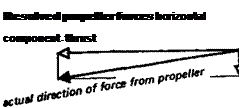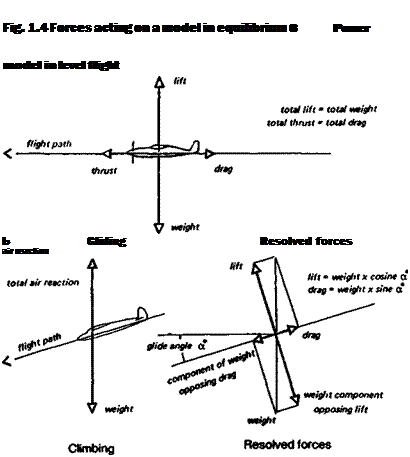RESOLUTION OF FORCES
A power model in level flight is under foe influence of many forces acting on every part of it but these may all be added and sorted out into four general forces arranged in action-
reaction pairs. The main upward support comes from the wings, but the tailplane also may provide some lift, so its contribution must be added to the total vertical reaction. The propeller shaft may not be aligned exactly along the flight path. This is not only because the model operator may deliberately mount the motor at an angle to the datum line of the fuselage (so-called downthrust or upthrust), but because the fuselage itself may not be aligned to the airflow at the particular speed of flight concerned. How much upward or. downward force results from this may be gauged by the trick of resolving forces. As Figure 1.3 shows, any force may be represented, diagrammatically, by an arrow which points in the same direction as the force acts, drawn to a definite scale. A force of three Newtons, for example may be represented by an arrow or ‘vector’ three centimetres long

a Model trimmed to fly nose up [notclimbing]
 verticaI component opposing lift
verticaI component opposing lift
 |
|
|

pointing in the required direction. Other forces and directions would then have arrows of proportionate length. To resolve the force from the propeller, into one component along the flight path and one directed vertically, the original arrow is drawn as the diagonal of a rectangle. The length and directions of the two sides of the rectangle then show, to the chosen scale, both the direction and strength of the contribution made by the propeller to thrust and vertical forces. In most cases the propeller shaft will not be very far from alignment with the flight path, so the bulk of the propeller force goes to thrust These principles of force resolution are very widely applicable. In Figure 1.4a, a power model is shown in level flight. It is acted on by four forces at right angles: thrust opposed by drag, weight opposed by lift This is the simplified diagram resulting from numerous additions and resolutions of small forces each making its individual contribution. If the tailplane is exerting a slight downward force to maintain the trim of the model, this has ben subtracted from the total lift In the same way the drag of the wing, tail, fuselage and undercarriage has been totalled. For level flight in equilibrium, the final result must be as shown.











